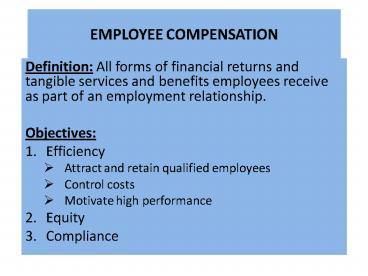EMPLOYEE COMPENSATION - PowerPoint PPT Presentation
1 / 17
Title:
EMPLOYEE COMPENSATION
Description:
My Pay vs. Other's Pay. My qualifications Other's qualifications. My work done Other's work done ... Assessing similarities and differences among jobs within a ... – PowerPoint PPT presentation
Number of Views:2551
Avg rating:3.0/5.0
Title: EMPLOYEE COMPENSATION
1
EMPLOYEE COMPENSATION
- Definition All forms of financial returns and
tangible services and benefits employees receive
as part of an employment relationship. - Objectives
- Efficiency
- Attract and retain qualified employees
- Control costs
- Motivate high performance
- Equity
- Compliance
2
The Perceived Equity of PayA Comparison of
Ratios
- My Pay vs. Others Pay
- My qualifications Others qualifications
- My work done Others work done
- My product value Others product value
3
Step 1 Internal Consistency
- Focus on internal comparisons
- Assessing similarities and differences among jobs
within a single organization, and the relative
contribution of the jobs to organization
objectives. - Establishing equal pay for jobs of equal worth
and acceptable pay differentials for jobs of
unequal worth.
4
Internal Consistency (contd)
- Key considerations
- Egalitarian v. hierarchical structure
- Single v. multiple structures
- Job-based v. person-based structure
- Key activity Evaluation of worth
- Ranking (most subjective)
- Classification
- Point method (least subjective)
5
Developing the Point Method
- Select compensable factors
- Characteristics of jobs that the organization
values and chooses to pay for - Consider the work, the organization, and the Ees
- Assign relative weights to each factor
- Reflect relative importance of the factor
- Weights should total to 100
- Weights are the same for all jobs
- Define factor degrees
- Represent different levels of requirements
associated with each factor
6
Implementing the Point Method
- Evaluate the worth of each job
- Read the job description
- Select the appropriate degree for each factor
- Multiply the degree by the factor
- Total the points for all factors
- Summarize your results
- Degrees/points for each factor for each job
- Summary job structure
- Total points for each job, in descending order
7
Step 2 External Competitiveness
- Focus on external comparisons
- Pay relationships among organizations competing
in the external labor market - Pay comparisons for the same jobs across
different organizations
8
External Competitiveness Key Activities
- 1. Setting a pay policy relative to competitors
- Options
- Lead
- Lag
- Match
- Variable
- Constraints/Considerations
- Organizational conditions
- Labor market conditions
- Product market conditions
9
External Competitiveness Key Activities (contd)
- Measuring the market
- The myth of the market wage
- Estimating the market pay line
- Salary (j.e. points) (x)
- Regression analysis
- Pay per point
- Creating a pay policy line
- Creating pay grades/bands and ranges
10
COMPARABLE WORTH
- Definition A doctrine that maintains that women
performing jobs judged to be equal on some
measure of inherent worth should be paid the same
as men. - The Problem The earnings gap
- The Cause
- Differences in human capital, or
- Occupational crowding into low-paying jobs
- Choice or discrimination?
11
Step 3 Recognizing Employee Contributions
- Focus on comparisons of individual employees
doing the same job for the same firm. - Key Issues
- Should differences in employee contributions be
recognized (flat rates v. ranges)? - What type(s) of contributions should be rewarded
(seniority, performance)? - At what level of performance (individual v.
group) should pay increases be determined? - Which technique should be used to reward
differences in contributions?
12
Should Pay Be Tied to Performance?
- Impact on equity objectives
- Is it fair to base pay on performance?
- Is it fair not to base pay on performance?
- What do employees believe?
- Impact on efficiency objectives
- Can pay be used to improve performance?
- What is the impact of pay-for-performance on
turnover?
13
To What Level of Performance Should Pay Increases
be Tied?
- Individual-level performance
- Theoretically establishes a close link between
individual performance and pay - Encourages competition
- Discourages focus on team work
14
- Group-level performance
- Aligns the interests of employees with those of
the group - Encourages team work and flexibility
- Weakens the link between individual performance
and pay - Free rider problem
- Ties pay to outcomes over which employees have
limited control
15
Choosing a Technique for Rewarding Performance
An Expectancy Theory Framework
- Effort Task/Goal Reward
- Accomplishment
- Expectancy Instrumentality Valence
16
Assessing the Likely Impact of a
Pay-for-Performance Plan on Motivation
- The Analysis
- To what outcome is the pay increase tied?
- Are employees likely to believe they can do it?
- How much control do employees have over the
outcome? - Do employees have the needed skills, knowledge,
and abilities? - If not, expectancy perceptions are low.
17
The Analysis (contd)
- Do employees believe that, if they reach the
goal, a reward will follow? - Consider employee relations
- Consider the firms ability to pay
- If not, then instrumentality perceptions are low
- Is the reward valued by employees?
- Just noticeable difference (JND)































